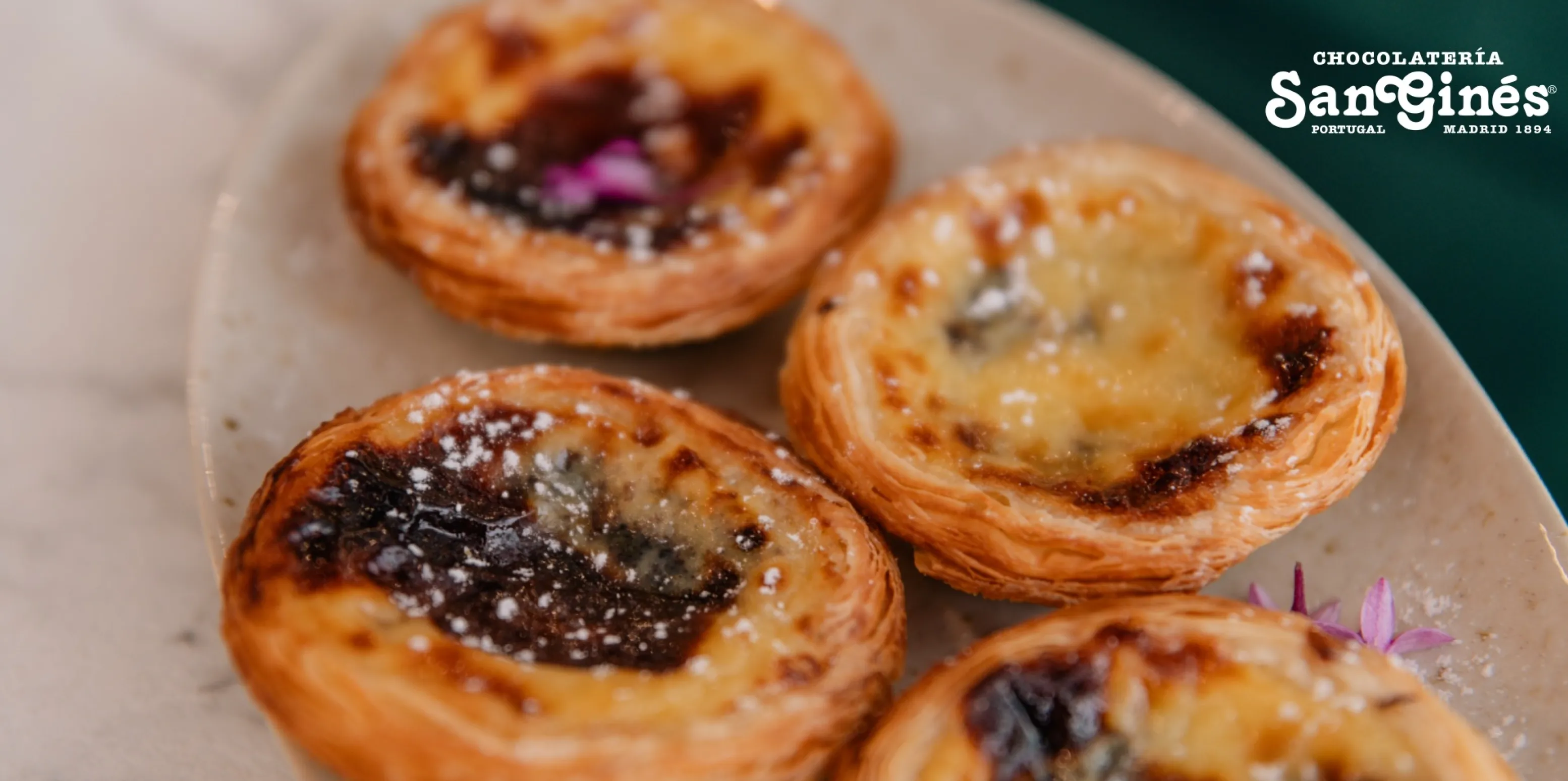Pastel de nata: which are the most traditional and their history

Lisbon: A City of History, Culture, and Culinary Delights
Lisbon, the vibrant capital of Portugal, is a city that captivates visitors with its rich history, stunning architecture, and delicious culinary offerings. Among the many gastronomic treasures of the city, few sweets are as iconic as the beloved Pastéis de Nata. These delicious custard tarts, wrapped in a golden flaky pastry, represent more than just a dessert; they are a symbol of Portugal's culinary heritage and artisanal skill.
For anyone visiting Lisbon, indulging in a Pastel de Nata is not just a suggestion; it is a culinary rite of passage. The city boasts countless pastry shops, each showcasing its unique interpretation of this traditional delicacy. However, amidst the well-established favorites, a new contender has emerged, generating a buzz: San Ginés Portugal.
The Origins of Pastel de Nata: A Symbol of Portuguese Gastronomy
To truly appreciate the charm of Pastel de Nata, one must delve into its origins. The story begins in the late 17th century in the historic neighborhood of Belém, known for its impressive monuments and significant role in Portugal's history. It was here, within the walls of the Jerónimos Monastery, that monks began crafting these delightful treats as a way to use up leftover egg yolks.
During this time, egg whites were often used for starching clothes, resulting in a surplus of yolks. Ingenious and resourceful, the monks decided to make good use of these yolks by creating a sweet that would later become a national treasure.
The recipe for Pastéis de Nata remained a closely guarded secret for many years, known only to the monks and passed down through generations. However, in 1834, when the monastery faced closure, the monks sold the recipe to a nearby sugar refinery, which eventually became the famous Pastéis de Belém pastry shop.
While Belém may be the birthplace of Pastel de Nata, its popularity has transcended regional borders. Today, these custard tarts can be found in pastry shops and cafés throughout Lisbon, each offering its interpretation of the classic recipe. But with so many options available, how do you determine which establishments truly deserve your time and palate?
The Art of Making Pastéis de Nata
Creating the perfect Pastel de Nata is an art form that requires skill, patience, and attention to detail. The process typically involves several steps:
1. Preparing the Pastry: The base of Pastel de Nata is made from laminated dough, similar to puff pastry. This dough is rolled and folded several times to create thin layers, resulting in a flaky texture when baked.
2. Preparing the Filling: The custard filling is prepared using egg yolks, sugar, milk, and sometimes cream. The mixture is carefully cooked until it reaches a smooth and creamy consistency.
3. Assembling the Tarts: Once the pastry is ready, it is cut into circles and placed in muffin tins. The custard filling is poured into the pastry shells, which are then baked at high temperatures until the tops are caramelized and the pastry is golden.
4. Serving: Traditionally, Pastéis de Nata are served warm, often sprinkled with a dash of cinnamon or powdered sugar on top.
How to Enjoy Pastéis de Nata Like a Portuguese
Once you’ve secured your Pastéis de Nata from San Ginés Portugal or any other reputable pastry shop, there is just one thing left to do: savor them! Here are a few tips on how to enjoy these delights like a true Lisboeta:
- Pair them with Coffee: In Portugal, it’s common to enjoy a Pastel de Nata alongside a coffee. The bitterness of the coffee perfectly balances the sweetness of the tart, creating a delicious contrast that enhances the overall experience.
- Add a Touch of Cinnamon: While Pastéis de Nata are delicious on their own, many locals like to sprinkle a bit of cinnamon or powdered sugar on top. This adds an extra layer of flavor and is a traditional way to enjoy this delicacy.
- Consume Them Fresh: The Pastel de Nata is best enjoyed fresh out of the oven when the pastry is still crispy and the filling is warm and creamy. If possible, try to eat them on-site to experience them at their peak.
- Take Your Time: These treats are meant to be savored, so don’t rush the experience. Take a moment to appreciate the texture, flavors, and artistry that went into their creation.
The Most Classic Places to Enjoy Pastéis de Nata in Lisbon
1. Pastéis de Belém: Perhaps the most famous pastry shop of all, it is celebrated for its secret recipe. The tarts are served warm, dusted with cinnamon and powdered sugar, making it a must-visit for any tourist.
2. Manteigaria: Known for its crispy texture and smooth custard filling, Manteigaria is a must-visit for those seeking an authentic experience. The pastry shop produces these delights daily, ensuring freshness with every bite.
3. Fábrica da Nata: Combining tradition with a modern twist, Fábrica da Nata offers a charming atmosphere to enjoy their tarts, accompanied by a cup of coffee on their terrace.
4. Nata Lisboa: With several locations, Nata Lisboa provides a contemporary atmosphere and a variety of flavors, including vegan options. It’s a great place to enjoy a sweet treat in a relaxed setting.
5. Confeitaria Nacional: This historic pastry shop has been serving customers since 1829. Known for its rich history and delicious treats, it has delighted generations with its exquisite offerings.
San Ginés Portugal: Tradition and Innovation in Lisbon
San Ginés Portugal stands out as a must-visit destination for those looking to experience one of the best Pastéis de Nata in Lisbon. This establishment is where tradition meets innovation, resulting in a unique flavor experience that is sure to delight.
San Ginés, with over 120 years of history in Spain, is famous for its churros with chocolate and has brought its commitment to quality to Portugal. Collaboration with João Fração, a renowned chef and MasterChef competitor, has led to the creation of an exceptional version of Pastel de Nata, respecting tradition while offering a modern twist.
Two Variants of Pastéis de Nata at San Ginés
At San Ginés Portugal, you can enjoy two highlighted versions of Pastel de Nata:
1. Classic Pastel de Nata: This delicacy, crafted by João Fração, features a golden, crispy crust and a smooth custard filling with notes of vanilla and lemon. It is a celebration of traditional Portuguese flavors.
2. Chocolate Pastel de Nata: For those seeking something different, this version incorporates San Ginés' famous chocolate, creating an irresistible fusion that elevates the classic to new heights.
A Must-Visit in Lisbon: Experience San Ginés
Visiting San Ginés Portugal is an experience that beautifully combines tradition and innovation. The quality of its ingredients, the welcoming atmosphere in Cais do Sodré, and the opportunity to take home a piece of this culinary history make your visit to Lisbon incomplete without a stop here.
San Ginés Portugal not only offers exceptional pastries but also invites you to be part of a legacy that has endured for over a century. So why wait? Plan your visit and discover why their Pastéis de Nata are considered among the best in Lisbon.
The Cultural Importance of Pastéis de Nata
Beyond their delicious taste, Pastéis de Nata hold a special place in Portuguese culture. These treats are often associated with celebrations, family gatherings, and local traditions. In Portugal, sharing food is a way to connect with others, and Pastel de Nata is no exception.
Many locals have fond memories of enjoying these sweets with family and friends, whether at a café in the morning or as an afternoon snack. The act of savoring a Pastel de Nata while sipping coffee is a cherished ritual that embodies the Portuguese way of life.
The Global Love for Pastéis de Nata
The fame of Pastéis de Nata has transcended borders, winning fans worldwide. As Portuguese communities have spread globally, so has the love for these custard tarts. Many pastry shops in countries like Brazil, the United States, and Canada now offer their versions, introducing this delicious delicacy to new audiences.
International food festivals and culinary events often feature Pastéis de Nata, highlighting their popularity and the growing interest in Portuguese cuisine. Chefs and food enthusiasts are drawn to the challenge of perfecting the recipe, experimenting with flavors and techniques while honoring the traditional method.
Savoring Pastéis de Nata: A Global Perspective
While the classic Pastel de Nata remains a favorite, innovative chefs around the world are putting their personal twist on the dish. Some variations include flavors like matcha, salted caramel, or even tropical fruits. These creative adaptations showcase the delicacy's versatility and its ability to evolve while honoring its origins.
As travelers explore different countries, they often seek out local delicacies to try, and Pastéis de Nata have found their place on many "must-try" lists. This global appreciation for the treat highlights not only its delicious taste but also the cultural exchange that occurs through food.
The Future of Pastéis de Nata
As interest in Portuguese cuisine continues to grow, the future of Pastéis de Nata looks promising. New pastry shops are emerging, each offering its unique take on this classic delicacy. The challenge for these establishments will be to balance innovation with tradition, ensuring the integrity of the original recipe while catering to modern tastes.
In addition to new recipes and techniques, there is a growing emphasis on sustainability within the culinary world. Many pastry shops are now sourcing local and organic ingredients, adopting eco-friendly practices in their production processes. This shift not only benefits the environment but also enhances the quality and flavor of the treats.
Conclusion: A Sweet Journey Through Lisbon
Lisbon is a city that invites exploration, offering a blend of history, culture, and culinary delights. The Pastel de Nata, with its rich flavors and historical origins, serves as a delicious gateway to the heart of Portuguese gastronomy.
Whether you are visiting the iconic Pastéis de Belém, enjoying the cozy atmosphere of Manteigaria, or indulging in the innovative creations of San Ginés Portugal, each bite of a Pastel de Nata tells a story of tradition and craftsmanship.
As you stroll through the charming streets of Lisbon, remember to take a moment to savor this iconic delicacy. It is not only a treat for your palate but a sweet reminder of the vibrant culture and heritage that define this beautiful city. So, plan your visit, indulge in these custard tarts, and discover for yourself why Pastéis de Nata are a cherished part of Portuguese life.
Últimas noticias

